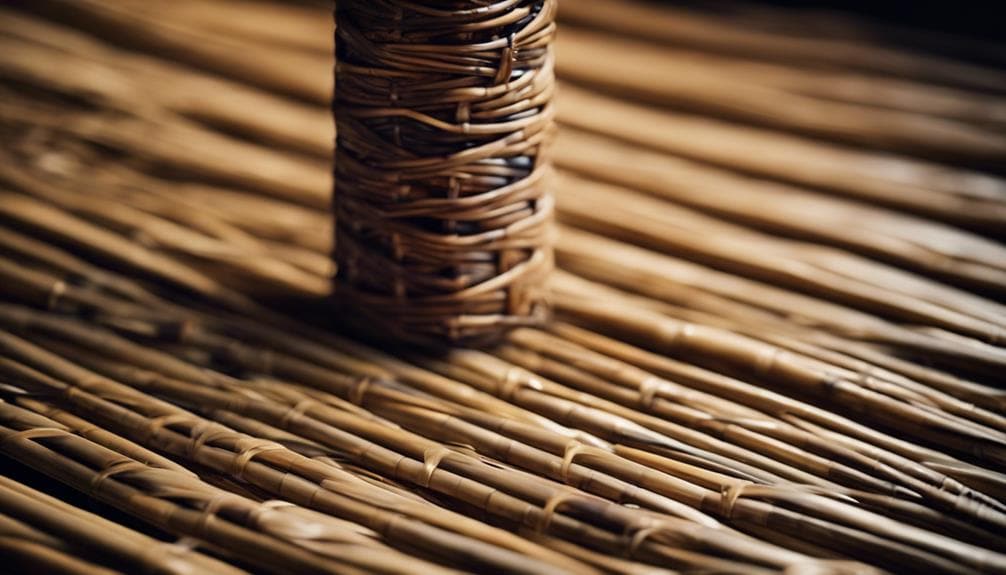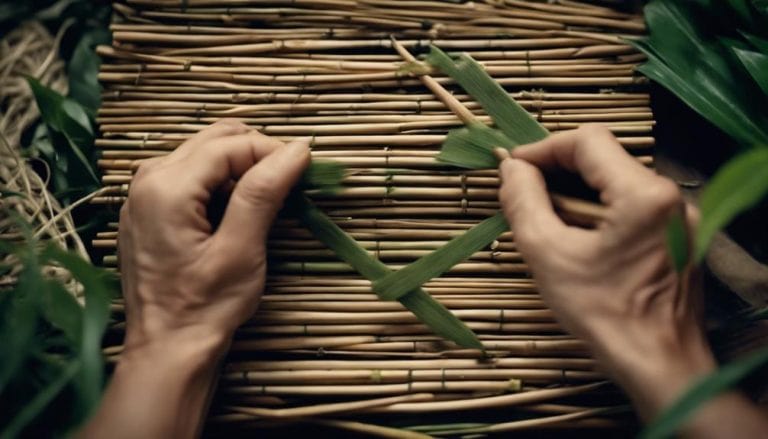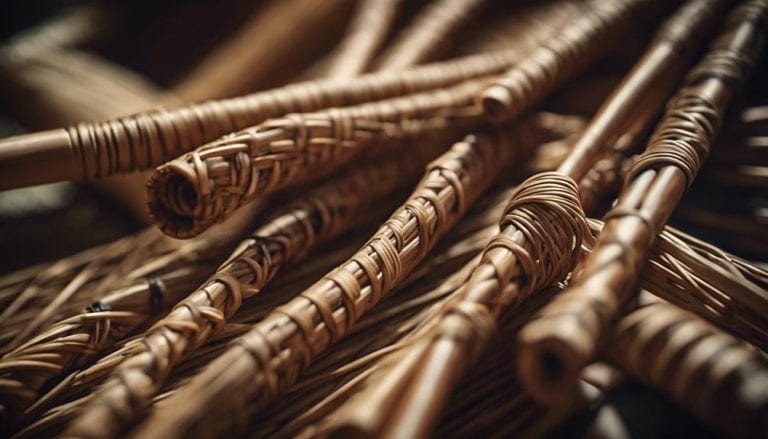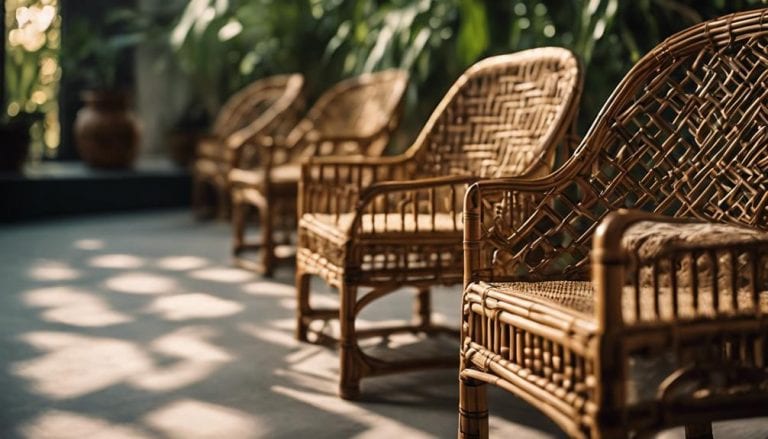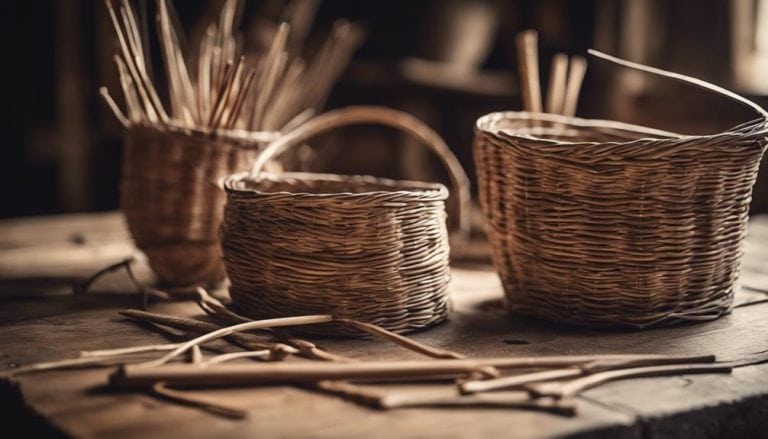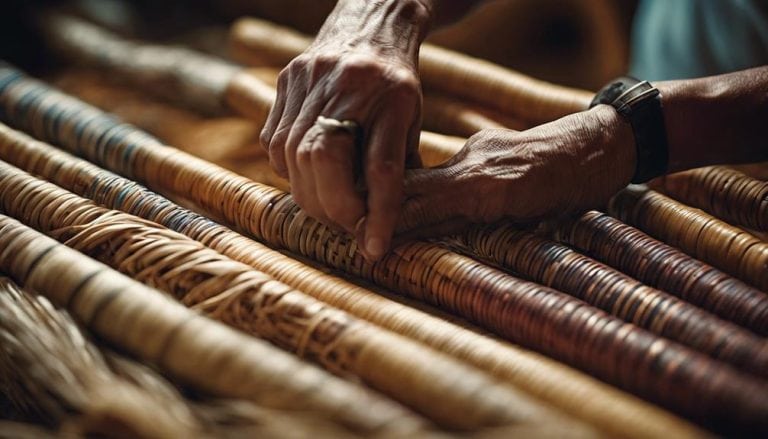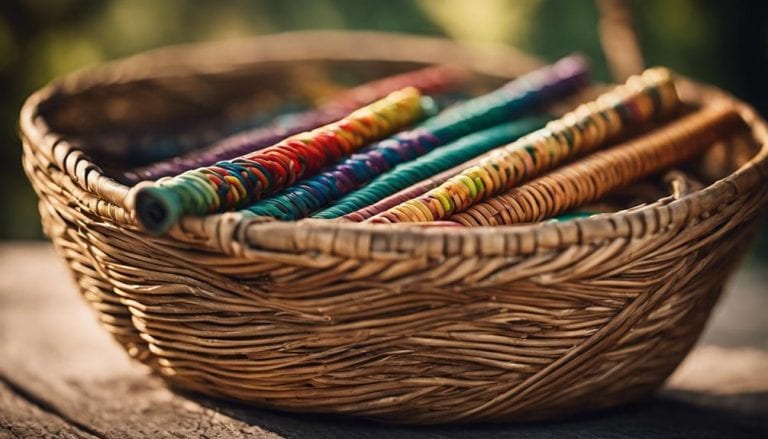Rattan Cane Vs. Other Materials for Weaving
Rattan Cane Vs. Other Materials for WeavingMany people aren’t aware that rattan cane, while visually similar to bamboo, surpasses its flexibility and durability, making it a superior choice for weaving intricate patterns in furniture and decor. I’ve explored various materials in my professional journey and found nothing quite compares to the unique blend of strength and aesthetic appeal that rattan offers.
However, the debate between using natural materials like rattan versus synthetic alternatives or other natural like wicker and bamboo is ongoing. There’s a lot more beneath the surface of this discussion, especially when considering factors like sustainability and the environmental impact of each material. Join me as we unpack the intricate details that set rattan apart and why it might be the better choice for your next project.
When comparing rattan cane to other materials for weaving, it is known for its durability and flexibility, making it a popular choice among weavers. Its natural properties lend themselves well to creating intricate and sturdy woven products.
Key Takeaways
- Rattan cane surpasses synthetic fibers in environmental sustainability and biodegradability, reducing its ecological footprint.
- It offers greater durability and strength than bamboo, ensuring long-lasting, maintenance-free products.
- The versatile design and natural aesthetics of rattan make it superior to other materials for both indoor and outdoor use.
- Rattan’s rapid regeneration and chemical-free cultivation highlight its eco-friendliness over other weaving materials.
Understanding Rattan Cane
Rattan cane, known for its durability and resistance to mold, stands out as a sustainable and versatile material for weaving and furniture making. I’ve delved into its unique characteristics, focusing on rattan durability and the intricate weaving techniques that harness its potential. This exploration has revealed the eco-centric values inherent in rattan’s cultivation and use.
Rattan’s strength and flexibility are unmatched, making it a superior choice for crafting durable furniture. Its resistance to mold is particularly noteworthy, ensuring longevity in humid environments where other materials might falter. Peeling rattan stems and splitting them into strands for weaving showcases the skill involved and highlights the material’s adaptability.
Sustainability is at the heart of Rattan’s appeal. Rattan plants regenerate quickly, underscoring the material’s environmental friendliness. This rapid growth cycle allows for a sustainable harvest, ensuring that rattan cane does not deplete resources or harm the ecosystem.
My analysis confirms that the unique properties of rattan cane, combined with sustainable harvesting and innovative weaving techniques, make it an eco-friendly and durable choice for furniture making and other crafts.
Rattan Versus Bamboo
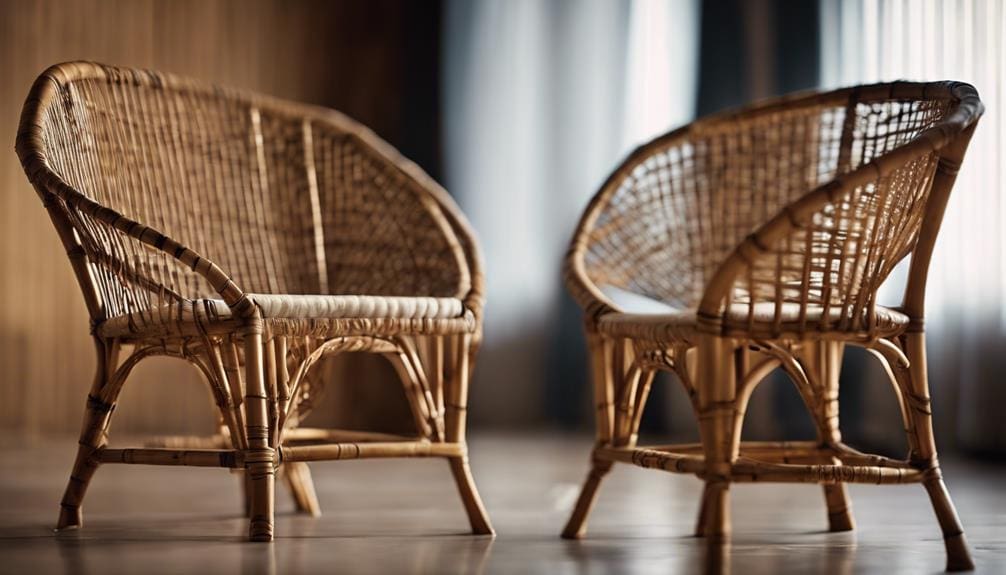
Having explored the unique characteristics and sustainability of rattan cane, we now consider how it compares with bamboo in weaving applications. When we delve into the nuances of these two materials, a few critical aspects emerge:
- Strength comparison and durability: Rattan, being a solid timber vine, inherently possesses a denser and stronger structure than bamboo, which is essentially a hollow, fast-growing grass. This fundamental difference contributes to rattan’s superior durability and longevity in woven products, making it a more robust choice for furniture that withstands the test of time.
- Texture differences, aesthetic appeal: The surface of bamboo is naturally smoother, offering a sleek look that appeals to modern and minimalist design sensibilities. In contrast, rattan features a more textured and natural appearance, adding a distinct aesthetic charm and highlighting the intricate craftsmanship involved in its weaving.
- Application versatility: While bamboo’s strength and lightweight properties lend it well to structural and construction purposes, rattan’s flexibility and durability make it the go-to material for high-quality, aesthetically pleasing woven furniture and decor items.
The choice between rattan and bamboo hinges on the intended application’s specific strength, texture, and aesthetic appeal requirements.
Rattan Versus Wicker
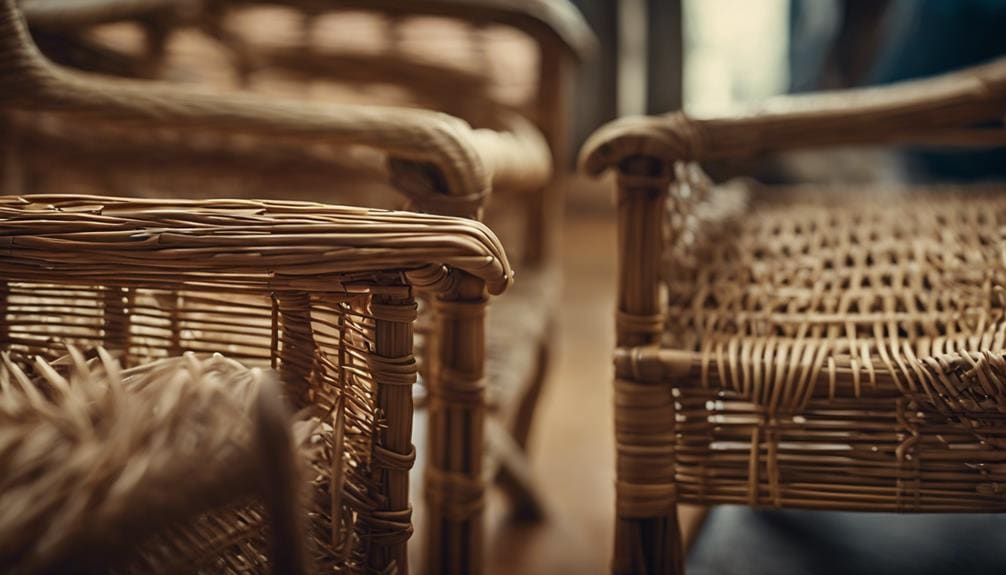
Diving into the comparison between rattan and wicker, it’s crucial to understand that while the former is a specific type of material, the latter encompasses a weaving technique that can incorporate various materials, including rattan itself. This distinction sets the stage for a unique durability comparison and offers a variety of maintenance tips tailored to each.
| Aspect | Rattan | Wicker |
|---|---|---|
| Material | Solid stems of a palm tree | Various (rattan, willow, bamboo, synthetic fibers) |
| Aesthetic | Natural beauty, limited color variation | A wider range of colors, patterns |
| Durability | 10-30 years with proper care | 5-15 years (natural), 10-20 years (synthetic outdoors) |
| Maintenance | Dusting, spot cleaning spills, protectant application | Vacuuming, rinsing with hose, spot cleaning spills |
| Unique Appeal | Classic styling, distinct natural beauty | Color options, pattern diversity, synthetic weather resistance |
Understanding these differences, I’m guided toward making more informed decisions based on aesthetic preferences, longevity expectations, and the anticipated commitment to maintenance. Whether I’m leaning towards the timeless appeal of rattan or the versatile charm of wicker, this analysis illuminates the path toward sustainable and eco-conscious choices in my home decor.
Comparing Rattan and Synthetic Fibers
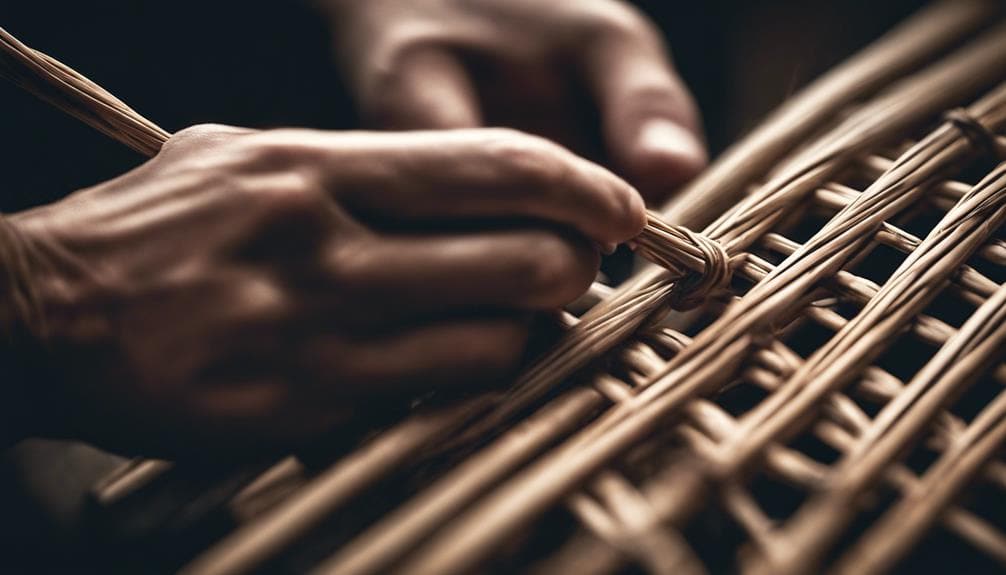
In evaluating the merits of weaving materials, we must consider how synthetic fibers, such as HDPE or PVC, stack up against rattan cane’s natural, eco-friendly attributes. The heart of this comparison lies in understanding their fundamental differences and how they impact their weaving use.
- Durability Comparison: Rattan cane, with its innate flexibility and resistance to mold, offers a durable option for weaving that ages gracefully. Conversely, synthetic fibers like HDPE and PVC are weather-resistant, making them ideal for outdoor furniture. These materials resist fading, cracking, and peeling far beyond what natural rattan can withstand, presenting a compelling argument for their use in harsher climates.
- Color Options: The natural hues of rattan cane provide an organic and serene aesthetic that blends seamlessly with outdoor environments. However, synthetic fibers bring an expansive palette of color options, allowing for customization and adaptability to modern design trends.
- Environmental Impact: While synthetic fibers offer practical benefits, their production and disposal raise concerns regarding environmental sustainability. Rattan cane, a natural and rapidly renewable resource, embodies a smaller ecological footprint, aligning with eco-conscious consumer values.
As we delve deeper into the characteristics of these materials, it’s clear that each offers unique advantages. The choice between rattan cane and synthetic fibers hinges on one’s values, particularly regarding durability, aesthetics, and environmental impact.
The Aesthetics of Rattan Weave
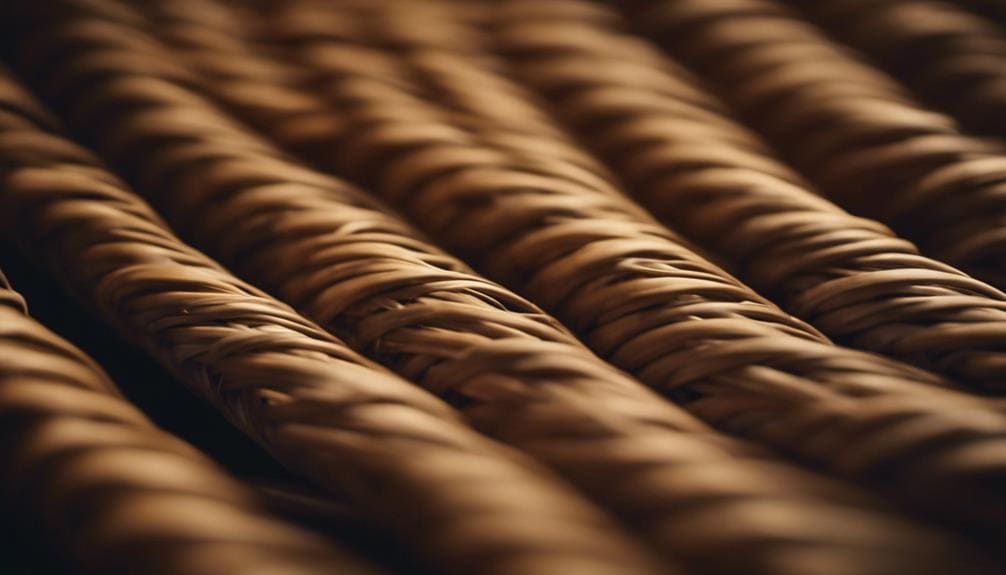
Moving beyond the functional aspects, let’s explore the aesthetic dimension of rattan weave, known for its natural charm and the elegance it adds to furniture design. With its organic texture and warm tones, rattan’s earthy aesthetic brings a sense of earth-friendly elegance into our living spaces. Its natural beauty is not just about looks; it’s about feeling closer to nature and appreciating the intricate patterns and designs that only skilled craftsmanship can create.
The unique weaving technique of rattan allows for lightweight and airy structures, perfect for crafting furniture that speaks to a relaxed and inviting atmosphere. This isn’t just about making a room look good; it’s about creating spaces that breathe and invite us to unwind.
Moreover, the durability and flexibility of rattan weave contribute to its timeless appeal. Whether it’s a piece of indoor elegance or an outdoor statement, rattan’s versatility in design ensures that it remains a sought-after material. Its ability to withstand various conditions without losing its charm adds to the natural beauty that makes rattan weave a classic choice for those seeking style and substance in their decor.
Sustainability and Eco-Friendliness
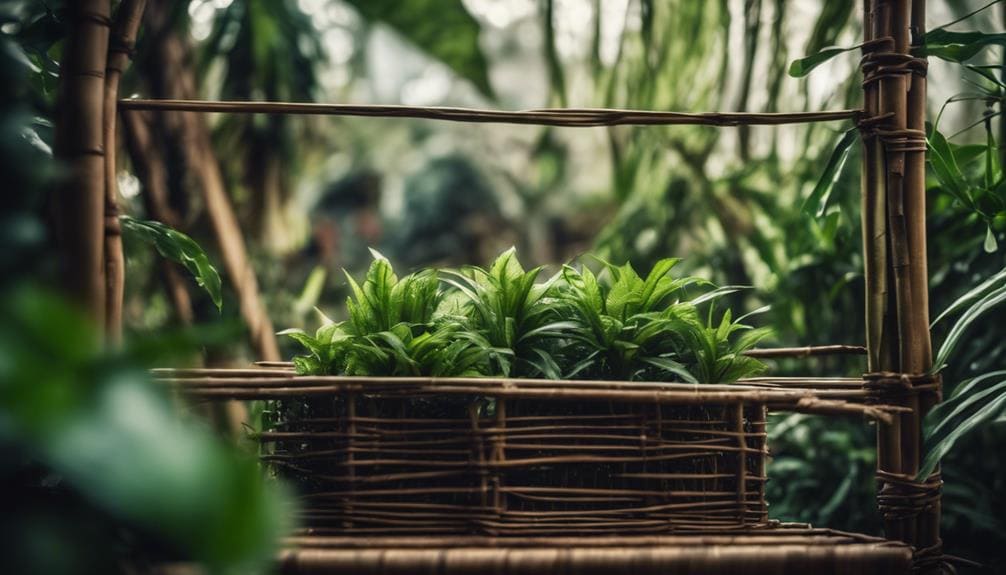
Exploring the sustainability and eco-friendliness of rattan cane reveals its significant advantages as a renewable and environmentally conscious choice for weaving materials. Its characteristics demonstrate a profound understanding of how we can harmonize with nature while crafting beautiful, durable products.
Here’s a closer look at its eco-friendly attributes:
- Rapid Regeneration: Rattan cane regrows in 5-7 years, underscoring its role as a sustainable resource. This swift cycle ensures a steady supply without depleting natural reserves, crucial for long-term environmental impact and resource conservation.
- Chemical-Free Cultivation: The absence of pesticides or fertilizers in its cultivation process not only preserves soil health but also minimizes water pollution, making rattan an exemplary material in terms of biodegradability and reducing our ecological footprint.
- Carbon Sequestration and Recycling: Being CO2-neutral, rattan cane contributes to the fight against climate change. Its ability to sequester carbon dioxide and recyclability makes it an environmentally responsible choice.
Understanding these aspects, it’s clear that rattan and cane stand out for their durability and minimal environmental impact. Their cultivation and use encourage us to think more deeply about our chosen materials and their long-term effects on our planet.
Frequently Asked Questions
What Materials Are Similar to Cane?
I’ve found materials like seagrass, willow, bamboo, and synthetic alternatives share historical usage with cane for weaving. These eco-focused options offer durability and versatility, appealing to those desiring a close, intimate connection with nature’s textures.
What Is the Difference Between Rattan and Weave?
Rattan’s sustainability sets it apart; it’s a durable material, not a technique. On the other hand, weaving is the art of intertwining materials like rattan. Together, they blend strength and beauty in eco-friendly designs.
Which Is Better, Rattan or Bamboo?
I believe rattan outshines bamboo when comparing sustainability and growth rate. Its strength and mold resistance make it superior for lasting furniture, aligning with an eco-conscious mindset and my preference for sustainable living choices.
Which Is Better, Rattan or Wicker?
I’d say rattan edges out wicker in durability comparison, especially for eco-conscious folks. It also demands less maintenance, making it a heartfelt choice for those valuing intimacy and sustainability in their surroundings.
Conclusion
In wrapping up, it’s clear that rattan cane stands out for its robustness, aesthetic appeal, and eco-friendly credentials. But here’s the kicker: as we dive deeper into sustainability, the choice between rattan, bamboo, wicker, and synthetics isn’t just about durability or looks. It’s about our planet’s future. Choosing rattan isn’t merely a design decision; it’s a step towards eco-responsibility. So, the next time you’re pondering over materials, remember that rattan isn’t just an option; it’s an answer.

